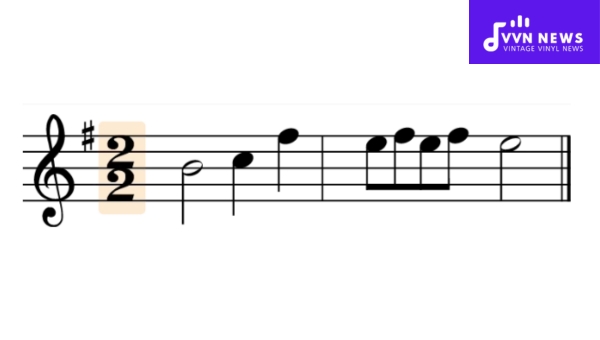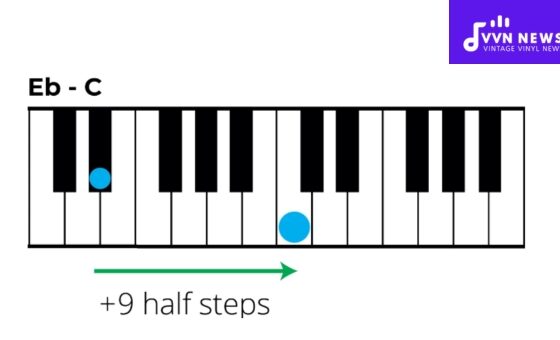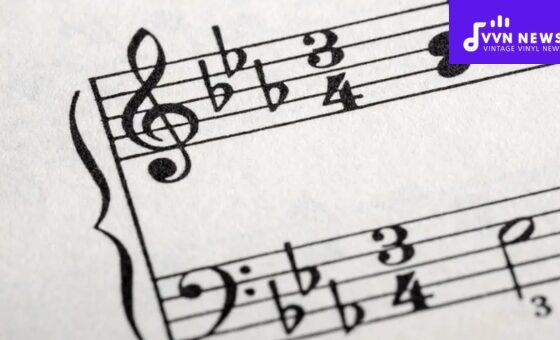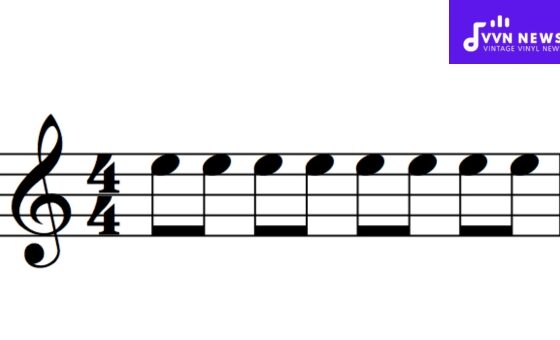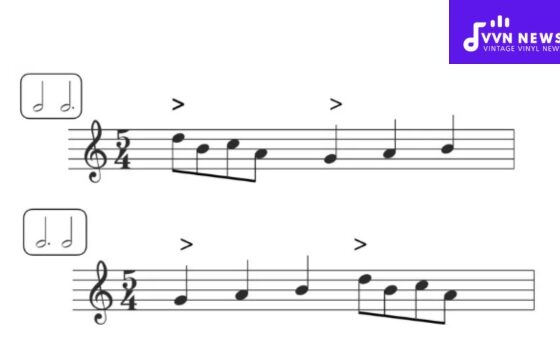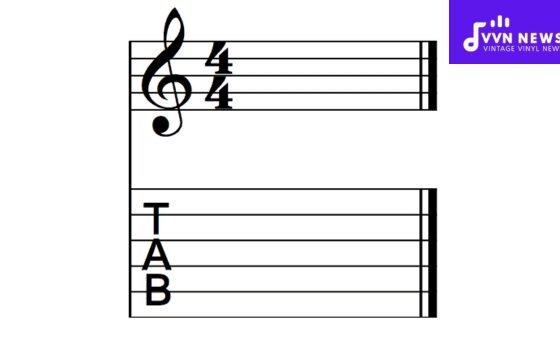Sometimes, when listening to music, you’ll find yourself tapping your foot to the rhythm or even conducting an imaginary orchestra with your hand.
What dictates this is a lesser-known element of music theory known as a time signature, specifically the time signature 2/2. Mastering this can enrich your listening experience and help you appreciate the intricacies behind how music is put together.
In music notation, the time signature holds a significant role. It lays down the heartbeat of a piece, guiding musicians on how to count beats in each measure.
The influence of time signatures spans different genres and cultures, affecting everything from symphonic compositions to rock ballads. Today, we’re delving into one specific time signature – 2/2 – and its impact on shaping music as we know it.
What defines a Time Signature 2/2?
A 2/2 time signature, noted by the fraction-like symbol at the beginning of a staff in sheet music, is fundamental in rhythmic structuring. It consists of two beats per measure, with each beat being a half note. Known as “Cut Time” or alla breve, this signature denotes a faster tempo.
The half note gets one beat instead of the usual quarter note seen in common time, which significantly influences the pace.
Consequently, one beats through a measure in 2/2 twice as quickly as one would in 4/4, giving pieces a lively momentum that’s easy for musicians to execute and for listeners to follow with brisk head nods or foot taps.
Also Read: How To Transpose Bass Clef To Treble Clef [A How-To Guide]
How is counting conducted in a Time Signature 2/2?
In a 2/2 time signature, each measure contains two half-note beats. Musicians count this as “1 – 2,” with emphasis on the “1,” which is the downbeat.
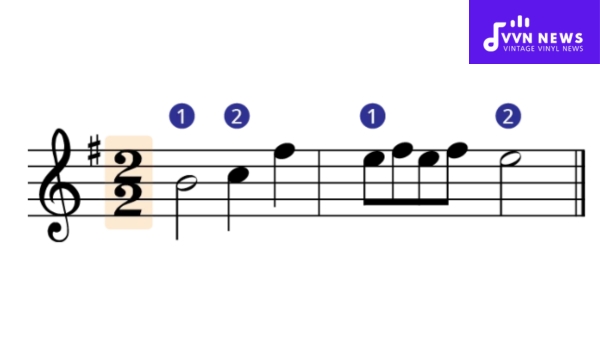
Imagine a conductor’s baton striking down on “1” and lifting on “2,” maintaining a steady, marching-like pace.
Visually, music notated in 2/2 will reflect fewer beats per bar, fostering a quicker flow of reading for the performer while retaining rhythmic clarity.
This economical method streamlines fast-paced compositions, allowing performers to process and execute music with efficiency.
Despite its brisk appearance, tempo isn’t dictated by time signature; so 2/2 can move at various speeds.
What Does It Mean When a Song Is in Cut Time?
When you encounter a song set in cut time, which is notated as 2/2, it’s like seeing the tempo through a magnifying glass.
Each measure is sliced into two half-note beats instead of four quarter-note beats as you’d see in common time (4/4). In this brisk musical environment, the conductor typically requires only two beats per measure—hence the term “cut” time.
Imagine you’re slicing the typical four-count of common time right down the middle. This results in a march-like cadence that propels music forward more swiftly and sharply.
Composers often employ cut time to inject their pieces with a sense of urgency and momentum.
Songs that Utilize a 2/2 Time Signature
Music is a universal language, speaking through beats and rhythms. The time signature, often unnoticed yet fundamental, acts as the rhythm’s guide.
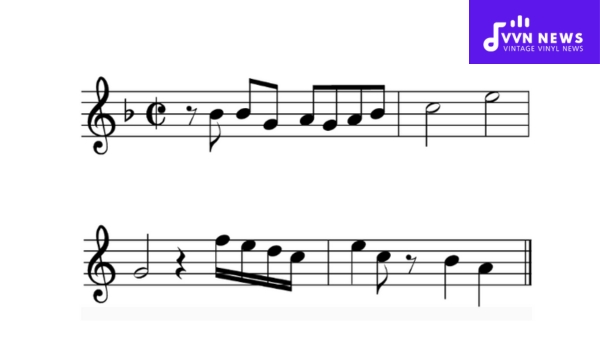
The 2/2 time signature, also known as Cut Time, offers a distinctive pace and feel, propelling music in ways that create dynamic march-like beats or elegant quick-step melodies.
Here are five songs that showcase the versatility of the 2/2 time signature:
“Sing, Sing, Sing (With a Swing)” by Louis Prima
This classic jazz piece exemplifies the driving pulse that 2/2 can produce. The song’s fervent energy is propelled by this brisk tempo – the snare drum delivering sharp rolls and hits that cut through the iconic brass sections.
“Stars and Stripes Forever” by John Philip Sousa
The quintessential patriotic march thrives under the baton of a 2/2 meter. Sousa’s famous work moves with a regal and deliberate pace; every beat is given prominence, echoing footsteps in a parade.
“The Blue Danube Waltz” by Johann Strauss II
Although typically heard in 3/4 time, many conductors interpret “The Blue Danube Waltz” in one beat per bar with fast-paced movements—a testament to its adaptability in both 3/4 and 2/2 time signatures.
“Air on the G String” by Johann Sebastian Bach
Bach’s celebrated composition encompasses an elegant interpretation of Cut Time. It allows for graceful bowing techniques from string players and breath control for wind instrumentalists within its steady march-like tempo.
“Can’t Stop” by Red Hot Chili Peppers
In contemporary music realms, “Can’t Stop” emphasizes rhythmic intricacies tailored around the Cut Time meter. From Flea’s bouncing bass to Chad Smith’s syncopated drum work—every note counts double-time.
Each of these pieces magnificently incorporates a 2/2 time signature to create diverse emotional landscapes and rhythmic expressions, highlighting just how influential this meter can be across various musical styles and eras.
Also Read: How To Transpose Music? [Simplifying Key Changes In Songs]
How Does Ear Training Relate to Recognizing Meters in Music?
When you’re tapping your foot or nodding your head to the rhythm of a tune, you are instinctively tuning into the song’s meter.
This intuitive response to music is more deeply informed by ear training, which is crucial for identifying the underpinnings of rhythm and meter in music.
Here are five points highlighting why ear training is so vital:
Hone Your Rhythmic Intuition
Ear training is an invaluable tool that assists in the internalization of rhythm, providing the ability to identify and follow various meters in music.
By developing this skill, one can sense a piece’s pulse without counting explicitly, feeling the meter organically through exposure and practice.
Improve Beat Detection
Good ear training drills involve recognizing where the strong beat falls within a measure.
In a 2/2 meter, there are two half-note beats per bar, with the first being accented.
Regular ear training exercises reinforce this awareness, making it second nature to pick up on these nuances when listening to any composition.
Enhance Sight-Reading
Musicians who sight-read benefit immensely from ear training as it reinforces their knowledge of rhythms, meaning they can proficiently navigate complex passages.
Skilled readers can often hear the rhythm internally before playing a single note.
Foster Time Signature Versatility
Effective ear training exposes one to a multitude of time signatures which fosters adaptability when encountering various pieces.
Individuals will not only excel with common signatures like 4/4 but also less conventional ones like 2/2 or 7/8 by feeling rather than calculating the rhythms.
Promote Ensemble Cohesion
Groups such as bands or orchestras rely on each member having a firm grasp of timing.
Through ear training, musicians synchronize their sense of timing with others, leading to tighter performances where everyone is locked into the same meter.
Ear training equips you with an innate comprehension of musical meters such as 2/2 without reliance on conscious counting or visual aides.
It supports your journey from simply following music to truly experiencing its rhythmic heartbeat.
Main Differences Between 2/2 and 4/4 Time Signatures
The world of music theory can be both fascinating and intricate. Two of the most common time signatures you’ll find are 2/2 and 4/4.
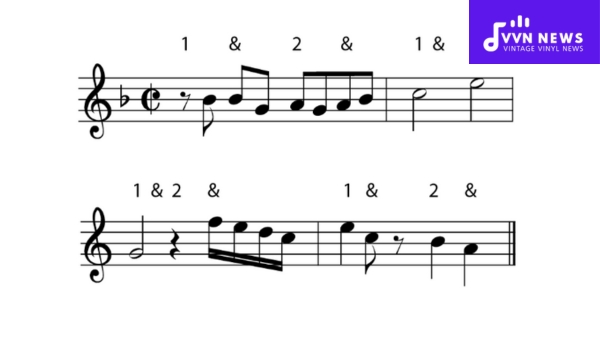
Let’s break down their primary distinctions:
Beat Division
In a 2/2 time signature, often referred to as “cut time,” there are two beats per measure and the half note gets one beat.
This results in a quicker tempo or at least the perception of a brisker pace.
On the flip side, 4/4 time, sometimes called “common time,” includes four beats per measure with the quarter note receiving one beat, establishing a steady and balanced rhythm.
Rhythmic Feel
Although both signatures share a similar structure, they differ in feel. Songs in 2/2 often exhibit a marching band’s bold, regimented cadence due to fewer beats demanding more emphasis on each.
In contrast, pieces in 4/4 can feel more relaxed and free-flowing because of their evenly spaced quarter-note pulses.
Conductor Patterns
If you’ve seen an orchestra in action, you might notice conductors use different patterns for various time signatures.
For 2/2, they’ll conduct with just two downward motions per measure; it’s straightforward but swift.
In comparison, conducting for 4/4 will follow a traditional four-pattern motion: down, left, right, up.
Perception of Speed
Songs notated in cut time may seem faster because musicians read them as having two strong beats per measure instead of four.
This psychological impact tends to make 2/2 feel brisk while retaining the ability to accommodate slower compositions at half-speed – which would still be counted faster than their 4/4 counterparts.
Musical Application
Genres like jazz or classical lean on cut time to deliver an energetic kick or support quick march-like tempos without cluttering the score with excessive eighth notes or sixteenth notes.
Meanwhile, rock, pop songs predominantly harness the flexibility of a 4/4 signature for its universal appeal and dance-friendly groove.
By spotlighting these distinctions between 2/2 and 4/4, musicians can not only exploit specific attributes inherent to each metric structure but also craft rhythms that appeal directly to our innate response.
Also Read: Transposition Chart [A Lifesaver For All Musicians]
FAQs
What exactly does “2/2” signify in a time signature?
The “2/2” represents two half-note beats per measure, meaning each half note gets one beat.
Is there another name for a 2/2 time signature?
Yes, it’s commonly referred to as Cut Time or Alla Breve.
Does music in 2/2 time feel different from 4/4 time?
Absolutely. While there are still four quarter-note beats total, music in 2/2 time often feels faster and more urgent due to its two strong beats per measure.
Are there any famous classical pieces written in 2/2 time?
Certainly! One example is Beethoven’s Symphony No. 3 in E-flat major, which uses a 2/2 time signature prominently.
Can beginners easily play pieces with a 2/2 time signature?
Yes, beginners can learn to play in 2/2 once they know how to count the two half-note beats properly.
Conclusion
Grasping the 2/2 time signature, or Cut Time, can be a game-changer for music enthusiasts and performers alike. It streamlines complex rhythms, allowing for a swift, marching tempo that propels compositions forward.
Recognizing this pulse can enhance both your listening pleasure and musical performance. Remember that 2/2 is more than just beats; it’s the soulful cadence that dances through some of your favorite tunes.
For practical examples, songs like “The Stars and Stripes Forever” showcase 2/2 in action. Your journey into time signatures will undoubtedly enrich your musical tapestry.
